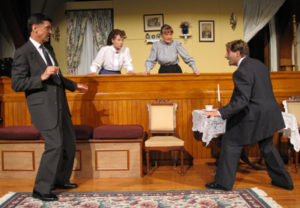In today’s Wall Street Journal I review two New Jersey revivals, Cape May Stage’s The Lion in Winter and East Lynne Theatre Company’s Arsenic and Old Lace. Here’s an excerpt.
* * *
 Plays that die on Broadway usually stay dead—but not always. Not only did James Goldman’s “The Lion in Winter” close in 1966 after a disappointing 92-performance run, but it had identically bad luck when it came back 33 years later, staying open for just 93 performances the second time around. Yet Goldman’s most popular play (he is now best remembered for having written the book for Stephen Sondheim’s “Follies”) still has a solid revival life elsewhere in America….
Plays that die on Broadway usually stay dead—but not always. Not only did James Goldman’s “The Lion in Winter” close in 1966 after a disappointing 92-performance run, but it had identically bad luck when it came back 33 years later, staying open for just 93 performances the second time around. Yet Goldman’s most popular play (he is now best remembered for having written the book for Stephen Sondheim’s “Follies”) still has a solid revival life elsewhere in America….
I last reviewed “The Lion in Winter” a decade ago at Chicago’s Writers Theatre, so when Cape May Stage announced its new production, it struck me as an opportune occasion to see how the play is holding up. A 30-year-old company headquartered in a deconsecrated Presbyterian church that has been converted into a plain but handsome theater, Cape May Stage has a long history of mounting well-directed small-scale productions of well-chosen small-cast plays in this seaside resort town at the southern tip of the Jersey Shore. I’ve seen the company do John Patrick Shanley’s “Doubt” and Theresa Rebeck’s “The Understudy,” in both cases to memorable effect, and this revival is fully as pleasing as its predecessors….
Roy Steinberg, who doubles as Cape May Stage’s artistic director, and Marlena Lustik, his real-life wife, lead the outstanding cast, delivering their sharp-toothed dialogue with lip-smacking relish. I wouldn’t want to have to choose between them for best-in-show honors—they are an ideally matched pair…
 Like Cape May Stage, East Lynne Theater Company performs in a church, but its performance space, the polygonal sanctuary of the First Presbyterian Church of Cape May, is still in regular use as a house of worship. As a result, East Lynne’s sets sometimes have a slightly sketchy feel, but its productions of older American plays leave nothing else to be desired. It’s hard to imagine a more diverting piece of summer fun than Gayle Stahlhuth’s revival of “Arsenic and Old Lace,” Joseph Kesselring’s improbably black 1941 comedy about a warm-hearted pair of little old ladies (Suzanne Dawson and Ms. Stahlhuth) whose charities include taking in lonely male boarders, putting them out of their misery by feeding them homemade elderberry wine laced with arsenic, cyanide and strychnine, then burying them in the cellar.
Like Cape May Stage, East Lynne Theater Company performs in a church, but its performance space, the polygonal sanctuary of the First Presbyterian Church of Cape May, is still in regular use as a house of worship. As a result, East Lynne’s sets sometimes have a slightly sketchy feel, but its productions of older American plays leave nothing else to be desired. It’s hard to imagine a more diverting piece of summer fun than Gayle Stahlhuth’s revival of “Arsenic and Old Lace,” Joseph Kesselring’s improbably black 1941 comedy about a warm-hearted pair of little old ladies (Suzanne Dawson and Ms. Stahlhuth) whose charities include taking in lonely male boarders, putting them out of their misery by feeding them homemade elderberry wine laced with arsenic, cyanide and strychnine, then burying them in the cellar.
A farce so soundly constructed that it all but plays itself, “Arsenic and Old Lace” is for that reason a staple of amateur companies throughout America. It is, however, far more rewarding to see it played by professionals who can get the most out of its macabre wit, and Ms. Stahlhuth’s production crackles with flawlessly executed touches of slapstick….
* * *
Read the whole thing here.
A scene from the 1968 film version of The Lion in Winter, starring Peter O’Toole:
A scene from the 1944 film version of Arsenic and Old Lace, starring Cary Grant, Jean Adair, and Josephine Hull:

 Paul Taylor, who died on Wednesday at the age of 88, was the dean of American choreographers—though that’s a strangely stiff word to use about a master of modern dance who was in private life far from formal. Even when he joined the members of the Paul Taylor Dance Company to take a bow at evening’s end, I can’t recall ever seeing him wearing anything but casual clothes, just as he usually spoke of his work, at least to journalists, in the lightest of tones. Only once did he break that rule in my hearing, when I asked him in an interview whether he thought his dances would survive him. He sat in silence for a moment, then replied, “I don’t know if they’ll last. I try to make them to last. They’re not made to be seen one time.” Nor were they…
Paul Taylor, who died on Wednesday at the age of 88, was the dean of American choreographers—though that’s a strangely stiff word to use about a master of modern dance who was in private life far from formal. Even when he joined the members of the Paul Taylor Dance Company to take a bow at evening’s end, I can’t recall ever seeing him wearing anything but casual clothes, just as he usually spoke of his work, at least to journalists, in the lightest of tones. Only once did he break that rule in my hearing, when I asked him in an interview whether he thought his dances would survive him. He sat in silence for a moment, then replied, “I don’t know if they’ll last. I try to make them to last. They’re not made to be seen one time.” Nor were they… What is it about Mr. Taylor’s work that inspires such enthusiasm? When it comes to “Esplanade,” the answer is self-evident: I don’t know another modern dance that speaks to the viewer with such immediacy and emotional openness. Yet the extroversion of “Esplanade” conceals the same heart of darkness that beats away in most of his other dances. The first time you see it, you’re left with an indelible mental image of dancers striding, flying, even sliding across the stage—but on second and third viewing, these pictures gradually give way to the remembered vision of a mysteriously androgynous, seemingly untouchable woman, searching in vain for a place in the indifferent world….
What is it about Mr. Taylor’s work that inspires such enthusiasm? When it comes to “Esplanade,” the answer is self-evident: I don’t know another modern dance that speaks to the viewer with such immediacy and emotional openness. Yet the extroversion of “Esplanade” conceals the same heart of darkness that beats away in most of his other dances. The first time you see it, you’re left with an indelible mental image of dancers striding, flying, even sliding across the stage—but on second and third viewing, these pictures gradually give way to the remembered vision of a mysteriously androgynous, seemingly untouchable woman, searching in vain for a place in the indifferent world….

 Mrs. T was discharged from New York-Presbyterian Hospital this afternoon and is now resting comfortably at our New York apartment. I’ve promised not to wake her up in the middle of the night to give her shots or take her temperature.
Mrs. T was discharged from New York-Presbyterian Hospital this afternoon and is now resting comfortably at our New York apartment. I’ve promised not to wake her up in the middle of the night to give her shots or take her temperature. Here’s my list of recommended Broadway, off-Broadway, and out-of-town shows, updated weekly. In all cases, I gave these shows favorable reviews (if sometimes qualifiedly so) in The Wall Street Journal when they opened. For more information, click on the title.
Here’s my list of recommended Broadway, off-Broadway, and out-of-town shows, updated weekly. In all cases, I gave these shows favorable reviews (if sometimes qualifiedly so) in The Wall Street Journal when they opened. For more information, click on the title. No visitors for now, please: Mrs. T still doesn’t have enough steam to receive guests. The good news, though, is that she’s well enough to have spent much of Tuesday reading some of the innumerable messages of love, concern, and support that so many of you have been posting on Twitter and Facebook throughout the past two weeks. I can’t begin to tell you how much those heartfelt messages have meant to her—and to me.
No visitors for now, please: Mrs. T still doesn’t have enough steam to receive guests. The good news, though, is that she’s well enough to have spent much of Tuesday reading some of the innumerable messages of love, concern, and support that so many of you have been posting on Twitter and Facebook throughout the past two weeks. I can’t begin to tell you how much those heartfelt messages have meant to her—and to me.